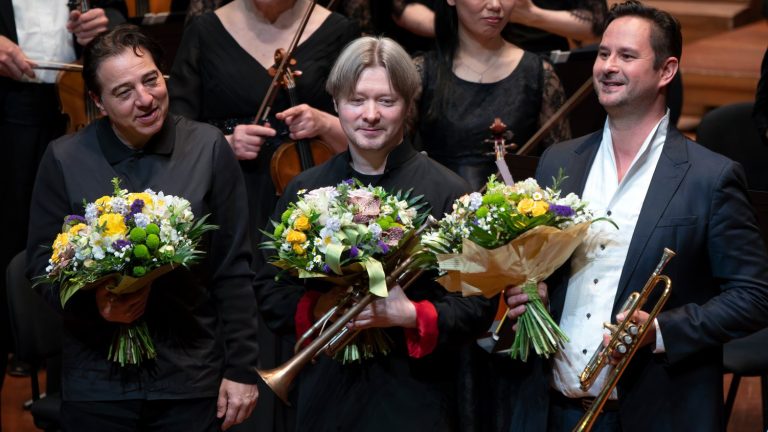“Tonight, folks, we have a really big show!” was always the way Ed Sullivan began his weekly television show. In his popular mid-20th century program, Sullivan hosted comics, opera singers, acrobats, top-40 pop, dancers, circus dogs and jugglers, and the American television debuts of Elvis Presley and the Beatles.
Müpa Budapest hosted “a really big” evening on May 13th featuring two debuts of two new masterworks, two trumpet stars, and the illustrious Prague Symphony Orchestra conducted by Andrey Boreyko. In this star-studded program, Müpa’s resident composer of the season Judit Varga’s “Happy Birthday Major Ludwig” received its Hungarian debut, and Müpa’s Artist of the season trumpeter Gábor Boldoczki gave the world premiere of Turkish composer Fazıl Say’s Concerto for Two Trumpets and Orchestra with fellow virtuoso trumpeter Sergei Nakariakov. For this occasion, Say himself appeared, as well.
Varga’s work was a wonderful example of what she calls “kinetic music” – her way of describing the kind of orchestral energy she evokes in her scores. As she is also a pianist, her spiritual linkage to Beethoven was further developed during the many musical celebrations of his 250th birthday festivities in Hamburg, resulting in her active homage to his monumental energy and momentum that characterize so many of his works. “Major” in the title can reference scalar harmony, military status, or great power that generates movement.
“Happy Birthday Major Ludwig” begins with pianissimo harmonics and moves into bird-like flutters in the woodwinds, then a tap on the triangle signals an approaching locomotive (or minor maelstrom) as the horns bellow with elephantine swoops. The atmosphere percolates with a momentary tip of the hat to Philip Glass’ infectious minimalism, suggesting a magical mystery tour. A piano solo bubbles up as the volcanic activity culminates into a high whistle before the architecture melts into a vast void. What a ride! Varga’s stellar orchestration employs symphonic instruments as if they were a huge set of painters’ brushes that spontaneously create voluptuous and vibrant panoramas.
Anatolian colors
Say’s composition, initiated by Boldoczki and commissioned by Müpa Budapest, was another whirlwind joy ride that covered a lot of earth’s territory. Say’s approach is not tonally complicated, yet the way he injects clever touches of near-East stylistic modes and rhythms into European conventions catapults us out of our seats.
After a shimmering and sustained open-fifth orchestral chord, the two trumpets began the first movement with a pointillistic conversation that eventually developed into a more florid exchange against the orchestra’s calm, ethereal canvas — until the bongo drums took over. Suddenly we were swept up in a Latin sway that added more and more percussion until a solemn motif entered and ended with a three-note theme — a quote from one of his signature piano pieces, “Dark Earth.”
The following two movements offered spacious romantic sequences with slithery Arabic string slides, vibraphones, dramatic brass chords, and Bulgarian 2-2-3 rhythms — all of which were a compelling complementary backdrop to the trumpet duo’s triple-tongued flourishes, leading the troops forward into a tempest of rhythmic ecstasy. Say’s sublime mixture of Anatolian colors and eastern modalities that he blends into a classical framework provides a fascinating exotic adventure.
With three kinds of trumpets (B-flat, piccolo, and flugelhorn) and various mutes, Boldoczki and Nakariakov had fun with Say’s curious musical dialogue like two kids in a sandbox. As an encore, they treated the audience to another dreamy duo: Bach’s sublime “Air on the G String” rearranged for two flugelhorns and orchestra.
Bohemian forests
After such an exhilarating musical kaleidoscope, it was another thrill to hear the glorious Prague Symphony Orchestra as they took their own spotlight with their own country’s music: Dvořák’s Symphony No. 8. A Czech orchestra playing Dvořák is akin to hearing a Hungarian orchestra play Bartók: you sense the DNA immediately.
Boreyko’s skillful leadership revealed this orchestra’s finest qualities: lusciously integrated strings, potent brass, expert woodwinds, and a brilliant percussion team, who sailed through Dvořák’s 19th century Bohemian forests, peasant dances, and sweet melodies with native gusto. I especially appreciated Boreyko’s allowing the French horns to shine that way Dvořák himself would have loved.
A “really big show” it was.











